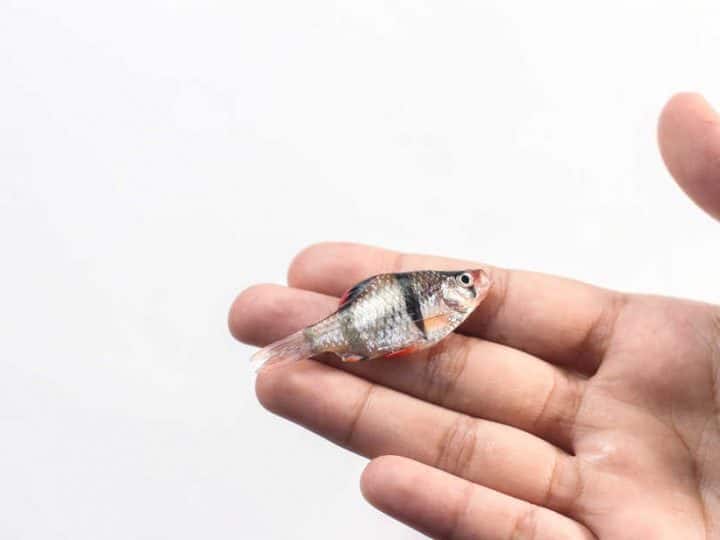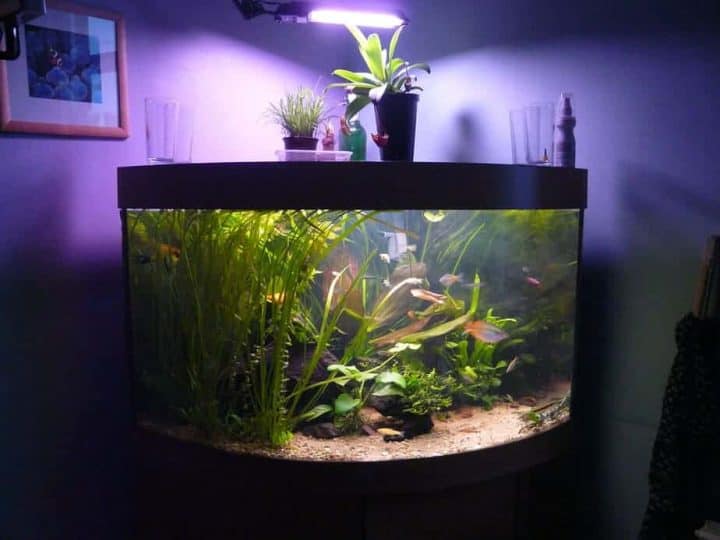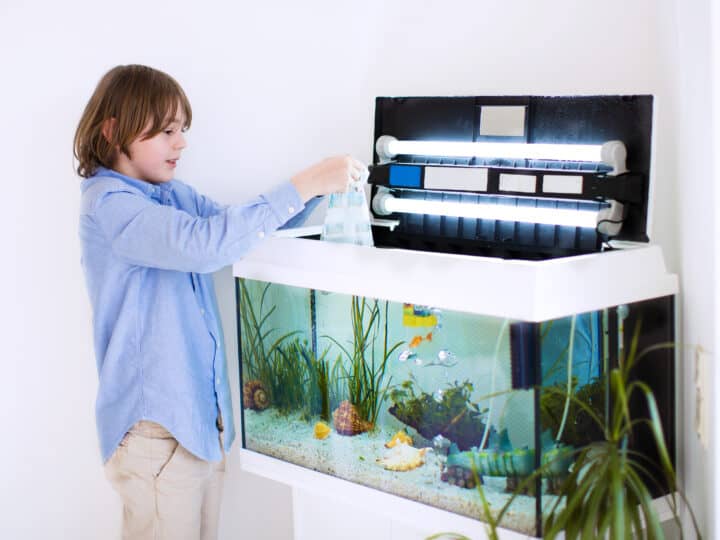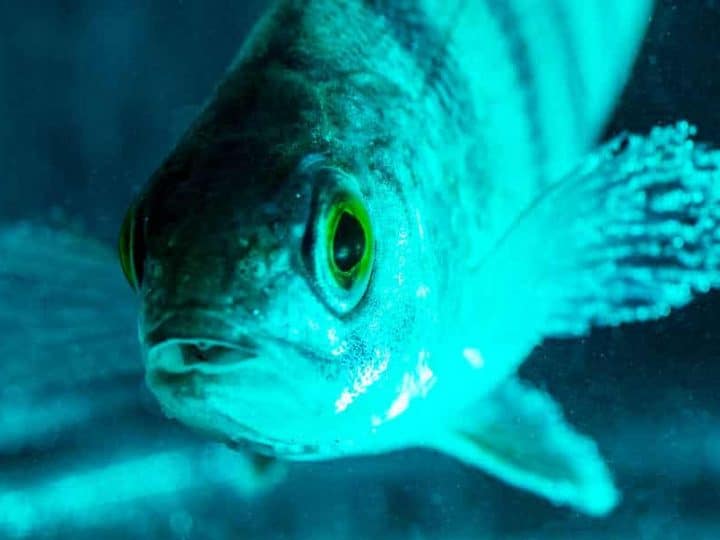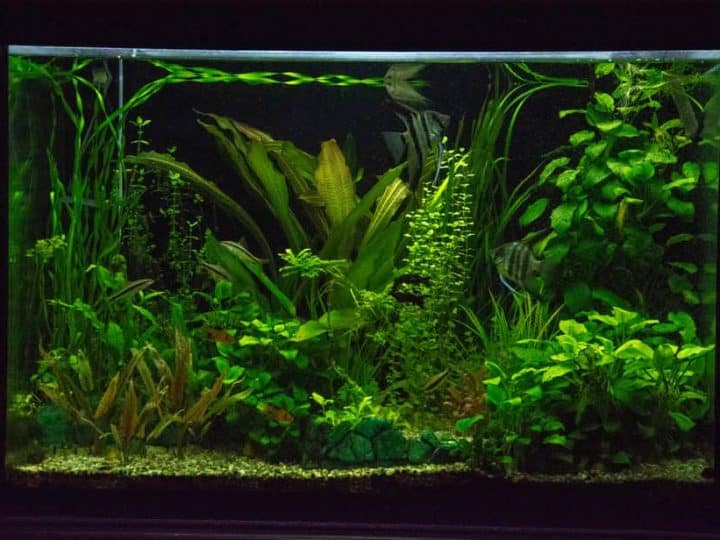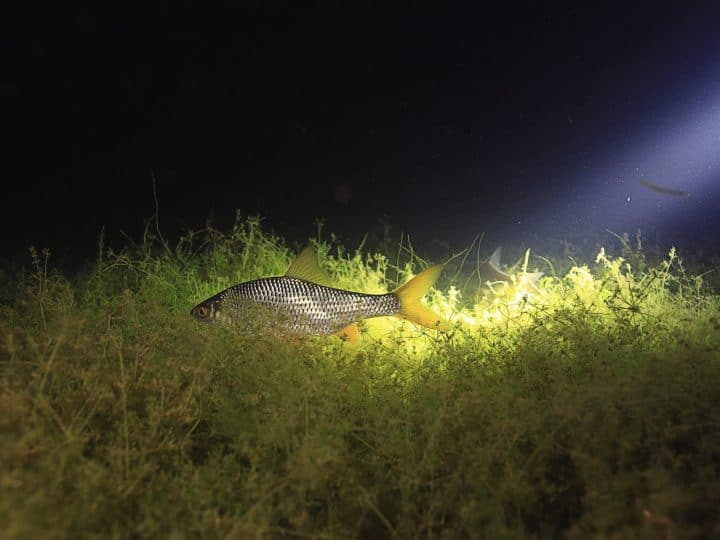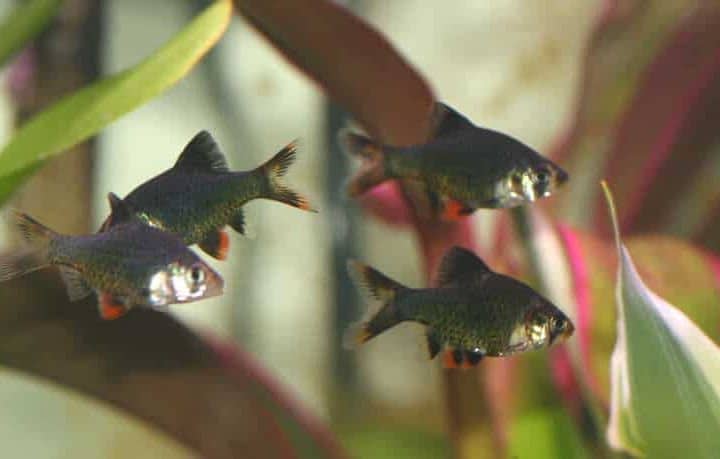If you’re thinking about getting a pet, but don’t want a significant expense, consider buying a fish. These small creatures are easy to feed, care for, and maintain. In addition, a 2019 study shows that fish can help soothe and relax the mind.
Quick Answer
The cheapest pet fish include the common goldfish, neon tetra, and zebra danios. Each of these fish cost around one to five dollars each (€0.85 to €4.27). Other inexpensive fish include mollies, guppies, cardinal tetras, and the corydoras catfish.
In this article, I’ll explore several species of inexpensive fish that are ideal for pets. In addition, I’ll cover some tips on how to enjoy more cost-effective fishkeeping.
What Is the Cheapest Fish to Buy as a Pet?
The cheapest fish to buy as a pet are specialist freshwater fish. The juvenile common goldfish, neon tetra, or danios are the most affordable. You can purchase these species of fish for under five dollars a piece.
The chart below shows a comparison of the cheapest pet fish. Below the chart, I’ll explore these low-cost, low-maintenance fish in more detail.
| Fish | Juvenile Price | Adult Price |
| Common Goldfish | $1 – 5 (€0.85 to €4.27) | Up to $30 (€25.63) |
| Neon Tetra | Around $1 (€0.85) | Up to $2 (€1.71) |
| Zebra Danio | Around $1 (€0.85) | Up to $5 (€4.27) |
| Mollies | $1 – 2 (€0.85 to €1.71) | Up to $4 (€3.42) |
| Guppies | $1 – 2 (€0.85 to €1.71) | Up to $4 (€3.42) |
| Cardinal Tetra | Around $2 (€1.71) | Up to $3 (€2.56) |
| Corydoras Catfish | Around $2 (€1.71) | Up to $25 (€21.36) |
Tied at #1 – Common Goldfish, Neon Tetra, and Zebra Danio
Juvenile Common Goldfish
The common goldfish or Carassius gibelio comes from the carp fish family. Interestingly, when humans in China first domesticated carp in 265 to 420 AD, these fish were a dull silver or grey color. Over time, mutations caused the species to change to its well-known yellow-orange hue.
Today, goldfish aren’t limited to a golden color for which they’re famed—some have yellow, orange, or red spots. Some even have different body colors, including black, brown, and red.
Apart from being inexpensive, the common goldfish is easy to find. They’re usually readily available at any neighborhood pet store.
In addition, these pet fish are easy to maintain. They’re not picky like some fish—they’ll eat almost anything. They can survive without a filter or heater, as long as you regularly change their water.
Unlike the other affordable fishes in this list, the common goldfish needs cold water. It’s best kept in a tank with a temperature of 65-72°F (18.33-22.22°C).
Juvenile Neon Tetra
First introduced in the 1930s, the neon tetra (Paracheirodon innesi) remains a favorite amongst hobbyists. Unlike other tetras, the neon tetra boasts a unique iridescent blue line across their bodies.
Neon tetras are both affordable and easy to keep.
When setting up a neon tetra tank, ensure that it’s designed with dark gravel, driftwood, or bogwood. Any of these help accentuate the tetra’s neon color. In addition, bogwood keeps the water acidic, which is what neon tetras prefer.
These small fish should be kept in schools. It’s ideal to keep at least five or six neon tetras together. If you must choose a different species, ensure that they’re smaller than the tetras. Don’t put neon tetras in a tank with larger fish, as they’ll become prey in no time!
As for the tank water, neon tetras like it soft, clean, and acidic. Likewise, they’ll thrive best in a temperature of 75°F (23.88°C).
As long as you follow these aquarium maintenance tips, you can expect your neon tetra to live for a decade. Don’t expect it to get big, though, as it can only grow a max of 2.5 inches (6.35 cm).
Juvenile Zebra Danios
As the name suggests, the zebra danio (Danio rerio) has a characteristic zebra-patterned body. This is precisely why it’s also known by the monikers zebrafish or striped danio.
This tiny fish won’t hurt your wallet. The zebra danio can only grow to a maximum length of 2.25 inches (5.71 cm). Because of this size, they’re best kept in a small aquarium with a capacity of at least 20 gallons (75.70 L). A smaller aquarium means a smaller expense.
Concerning temperature, zebrafish prefer a non-heated tank. They’re happy to swim in a tank with 60°F (15.55°C) water.
For best results, keep your zebra danio together with at least three to five fishes. While they’ll blend well with most, you shouldn’t place them with fish that get startled. Zebra danios are quick swimmers, after all.
Keep in mind that zebra danios are prolific breeders. Don’t be surprised if you see more juvenile zebrafish in your tank after a while.
Juvenile Mollies
Mollies (Poecilia sphenops) are yet another small, inexpensive freshwater fish. These fish look similar to a mix between tetras and goldfish. The two most common varieties include short-fin and sailfin. Short-fin mollies are smaller than their sailfin counterparts.
There are three common colors of mollies, including white, orange, and black. However, there are dozens of variations. Some mollies are blue, red, or green. In pet stores, there are marble mollies with orange, black, and yellow spots, as well as orange mollies with pink eyes.
The inexpensive price and ease of care are two reasons why Mollies are so popular. In addition, these creatures are generally peaceful—you can group them with other fish without many problems.
As long as you keep your mollies in a water temperature of 71-85°F (21.66-29.44°C), they should be fine.
Juvenile Guppies
Guppies (Poecilia reticulata) are the most widely available tropical fish in the market—that’s because they’re quick to reproduce! Known as the million fish (and rightly so), guppies are always in surplus. Their fast reproduction rate is one reason why they’re so inexpensive.
These fish are also sociable, yet peaceful, so you can place them with other small, friendly fish, such as Mollies.
To add to their benefits as pets, guppies require simple, straightforward care. Maintaining guppies won’t burn a hole in your pocket. Since they’re small, they’re perfect for a five-gallon tank. Just make sure it’s fitted with a filter and a heater. These fish need a temperature of 72-82 °F (22.22-27.77 °C).
Given these favorable conditions, your million fish will thrive well—and reproduce right away!
Juvenile Cardinal Tetra
As I mentioned earlier, tetras are noticeably cheap. The cardinal tetra (Paracheirodon axelrodi) is no exception.
This beautiful species makes for a dazzling, yet affordable, aquarium display. They boast trademark blue and bright red lines, while some feature magnificent gold lines. With these colors, it’s easy to become hypnotized with the cardinal tetra’s pattern.
As the cardinal tetra is a schooling fish, it’s best kept with other cardinal tetras. You need to be careful when mixing it with other breeds, however. They can easily fall prey to others—especially the other tetras!
Apart from grouping it with the right school, it would help to place your cardinal tetra in a well-planned tank. The water, for one, should be soft and acidic. The temperature should range from 73-81°F (22.77-27.22°C).
As for the setup, your tank should be heavily planted. This will help provide ample swimming and hiding space for your cardinal tetra.
Like the neon tetra, a cardinal tetra’s iridescent colors are emphasized in dark substrates, like gravel. Other tank additions to enhance their color include bogwood, driftwood.In addition, tetras are not fans of high illumination, so avoid harsh lighting.
Juvenile Corydoras Catfish
Corydoras Catfish (Corydoras paleatus), also known as the Cory Catfish, is an inexpensive, hardy freshwater fish. They come in a variety of types, with the most common being the Bronze Cory, or Green Cory.
The Cory Catfish grows to a maximum length of 2.5 inches (6.35 cm). While they may be small, these fish are armored—they have bone-like, plated material that covers their bodies. Because of how tough they are, these fish can live anywhere from five to ten years.
Their small size also allows them to live in small, ten-gallon tanks. Covering the aquarium with a screen is a must, however, as Corys love to jump.
When it comes to temperature, you can keep your Cory Cats cozy in 72-78°F (22.22-25.55°C) waters.
6 Tips and Tricks for Cost-Effective Fishkeeping
Upon first glance, fishkeeping appears to be rather inexpensive. After all, you can purchase certain species of fish for around a dollar.
However, buying fish is just the beginning of fishkeeping expenses. There are numerous other items you’ll need to purchase, including:
- Aquarium
- Air Pump
- Heater
- Substrate
- Fish Food
- Medication
- Water Additives (to maintain pH)
- Nets (for cleaning)
- Lighting
The cost of equipment and tools can pile up in the long run. You’ll need to follow a strict budget to keep things cost-effective.
Below, I’ll cover six tips and tricks to help you save money while maintaining your fish.
1. Go For a Used Aquarium
To keep costs at a minimum, start with a used, good-quality aquarium. In local sales ads, you may be able to pick one up for half of the usual price.
When purchasing a secondhand tank, however, check the photos carefully. If you can, inspect the aquarium before committing to the purchase. You don’t want to end up buying something that’s nearing the end of its lifespan.
Finally, ensure that you thoroughly clean and sanitize the aquarium before filling it and adding your fish.
2. But Keep an Eye on High-Quality Equipment
A second hand aquarium can save you money, but that’s not always the case for used heaters and filters. This equipment is prone to breaking down, so it can end up upsetting your tank’s cycle. This, in turn, can lead to sick fish that require expensive medicine.
With that said, don’t go for a cheap or secondhand heater or filter. Purchase something new and reliable. This will help save you from financial headaches in the long run.
The need for professional repairs can end up straining your budget as well. If this happens, it’s best to try patching these devices on your own.
3. Keep the Water Temperature Low
By choosing fish that thrive in cold water, you’re sure to save money by keeping the temperature low. Your aquarium’s heater, after all, is the biggest consumer in your setup.
For example, if you have goldfish, they prefer a temperature between 65-72°F (18.33-22.22°C). To save a little on energy costs, opt for the lower range, around 65°F (18.33°C).
4. Install LED Lights
Apart from the heater, your aquarium lights will use a lot of electricity. If you need to install lights for your fish, make sure to opt for LEDs.
While they’re costlier than other lights, they can help you save money in the long run, due to their energy efficiency.
For example, a five-meter (196.85 inch) LED light strip only has a wattage of 24. If you leave it on for twenty-four hours a day, all year long, it’ll only cost you around $25.23 (€21.56) for the whole year (based on the US average).
Don’t know the kWh cost in your state? You can check the estimate of your LED lights through this Appliance Energy Calculator.
5. Choose Easy Plants
As mentioned, cheap fishes like the cardinal tetra require a planted aquarium. Unless you’re mindful in picking a plant, you may end up spending a lot on plant food and CO2.
As a beginner, it’s easier (and cheaper) if you use these plants instead:
- Java Moss
- Brazilian Micro Swords
- Dwarf Baby Tears
- Water Wisteria
- Amazon Sword
Another way to keep your fishkeeping budget to a minimum is to join forums and clubs. Here, you can find fellow hobbyists selling cheap plant trimmings. Some are even willing to trade theirs for free.
6. Be On the Lookout for Fish Rehomers
The cheapest fish is always the free one!
If you’re curious enough, you’re sure to find a fishkeeper who’s looking to rehome their pets. It’s hard to resell one after all, which is why they often give their pets for free.
If you’re lucky enough, they may give away the aquarium as well!
Final Thoughts
If you’re on a tight fishkeeping budget, you can save money by buying cheap fish. The best examples are the common goldfish, neon tetra, and zebra danio. You can purchase such juveniles at around a dollar a piece.
Apart from buying inexpensive fish, some techniques can keep your fishkeeping costs at a minimum. They include getting a used aquarium, setting a lower temperature, and planting low-maintenance greens, to name a few.

